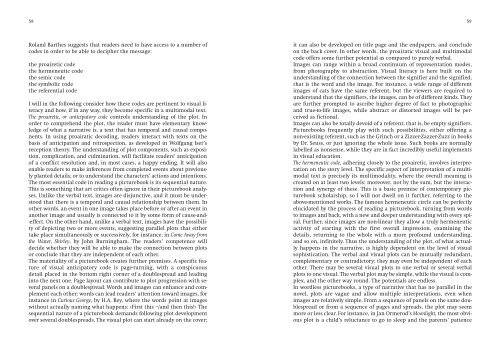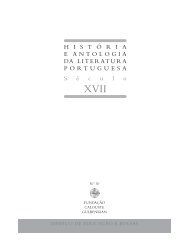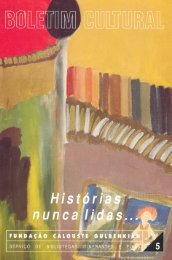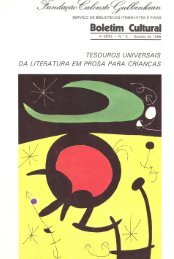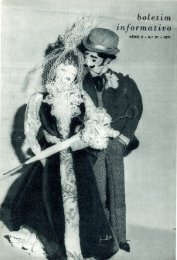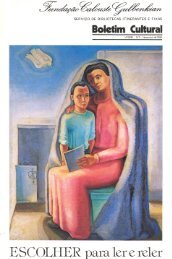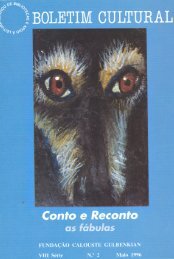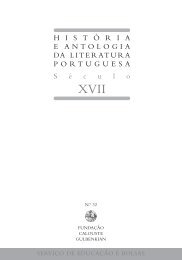Formar Leitores para Ler o Mundo - Leitura Gulbenkian - Fundação ...
Formar Leitores para Ler o Mundo - Leitura Gulbenkian - Fundação ...
Formar Leitores para Ler o Mundo - Leitura Gulbenkian - Fundação ...
Create successful ePaper yourself
Turn your PDF publications into a flip-book with our unique Google optimized e-Paper software.
58<br />
Roland Barthes suggests that readers need to have access to a number of<br />
codes in order to be able to decipher the message:<br />
the proairetic code<br />
the hermeneutic code<br />
the semic code<br />
the symbolic code<br />
the referential code<br />
I will in the following consider how these codes are pertinent to visual literacy<br />
and how, if in any way, they become specific in a multimodal text.<br />
The proairetic, or anticipatory code controls understanding of the plot. In<br />
order to comprehend the plot, the reader must have elementary knowledge<br />
of what a narrative is, a text that has temporal and causal components.<br />
In using proairatic decoding, readers interact with texts on the<br />
basis of anticipation and retrospection, as developed in Wolfgang Iser’s<br />
reception theory. The understanding of plot components, such as exposition,<br />
complication, and culmination, will facilitate readers’ anticipation<br />
of a conflict resolution and, in most cases, a happy ending. It will also<br />
enable readers to make inferences from completed events about previously<br />
planted details; or to understand the characters’ actions and intentions.<br />
The most essential code in reading a picturebook is its sequential nature.<br />
This is something that art critics often ignore in their picturebook analyses.<br />
Unlike the verbal text, images are disjunctive, and it must be understood<br />
that there is a temporal and causal relationship between them. In<br />
other words, an event in one image takes place before or after an event in<br />
another image and usually is connected to it by some form of cause-and-<br />
-effect. On the other hand, unlike a verbal text, images have the possibility<br />
of depicting two or more events, suggesting <strong>para</strong>llel plots that either<br />
take place simultaneously or successively, for instance, in Come Away from<br />
the Water, Shirley, by John Burningham. The readers’ competence will<br />
decide whether they will be able to make the connection between plots<br />
or conclude that they are independent of each other.<br />
The materiality of a picturebook creates further premises. A specific feature<br />
of visual anticipatory code is page-turning, with a conspicuous<br />
detail placed in the bottom right corner of a doublespread and leading<br />
into the next one. Page layout can contribute to plot progression with several<br />
panels on a doublespread. Words and images can enhance and complement<br />
each other: words can lead readers’ attention toward images, for<br />
instance in Curious George, by H.A. Rey, where the words point at images<br />
without actually naming what happens: «First this –/and then this!» The<br />
sequential nature of a picturebook demands following plot development<br />
over several doublespreads. The visual plot can start already on the cover;<br />
it can also be developed on title page and the endpapers, and conclude<br />
on the back cover. In other words, the proairatic visual and multimodal<br />
code offers some further potential as compared to purely verbal.<br />
Images can range within a broad continuum of representation modes,<br />
from photography to abstraction. Visual literacy is here built on the<br />
understanding of the connection between the signifier and the signified,<br />
that is the word and the image. For instance, a wide range of different<br />
images of cats have the same referent, but the viewers are required to<br />
understand that the signifiers, the images, can be of different kinds. They<br />
are further prompted to ascribe higher degree of fact to photographic<br />
and true-to-life images, while abstract or distorted images will be perceived<br />
as fictional.<br />
Images can also be totally devoid of a referent, that is, be empty signifiers.<br />
Picturebooks frequently play with such possibilities, either offering a<br />
non-existing referent, such as the Grinch or a Zizzer-Zazzer-Zuzz in books<br />
by Dr. Seuss, or just ignoring the whole issue. Such books are normally<br />
labelled as nonsense, while they are in fact incredibly useful implements<br />
in visual education.<br />
The hermeneutic code, adhering closely to the proairetic, involves interpretation<br />
on the story level. The specific aspect of interpretation of a multimodal<br />
text is precisely its multimodality, where the overall meaning is<br />
created on at least two levels; moreover, not by the sum, but the interaction<br />
and synergy of these. This is a basic premise of contemporary picturebook<br />
scholarship, so I will not dwell on it further, referring to the<br />
above-mentioned works. The famous hermeneutic circle can be perfectly<br />
elucidated by the process of reading a picturebook, turning from words<br />
to images and back, with a new and deeper understanding with every spiral.<br />
Further, since images are non-linear they allow a truly hermeneutic<br />
activity of starting with the first overall impression, examining the<br />
details, returning to the whole with a more profound understanding,<br />
and so on, infinitely. Thus the understanding of the plot, of what actually<br />
happens in the narrative, is highly dependent on the level of visual<br />
sophistication. The verbal and visual plots can be mutually redundant,<br />
complementary or contradictory; they may even be independent of each<br />
other. There may be several visual plots to one verbal or several verbal<br />
plots to one visual. The verbal plot may be simple, while the visual is complex,<br />
and the other way round. The potentials are endless.<br />
In wordless picturebooks, a type of narrative that has no <strong>para</strong>llel in the<br />
novel, plots are vague and allow multiple interpretations, even when<br />
images are relatively simple. From a sequence of panels on the same doublespread<br />
or from a sequence of pages and spreads, the plot may seem<br />
more or less clear. For instance, in Jan Ormerod’s Moonlight, the most obvious<br />
plot is a child’s reluctance to go to sleep and the parents’ patience<br />
59


